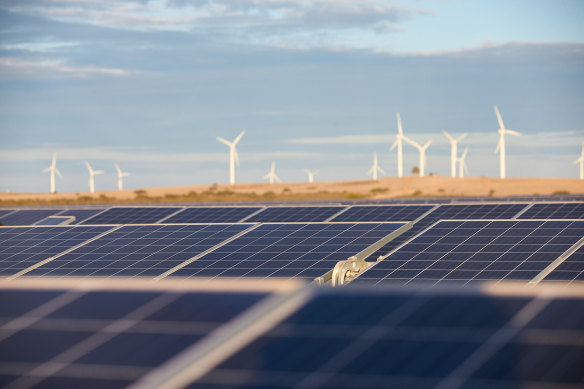By Mike Foley and Nick Toscano
The rise of renewable energy in the grid is driving down emissions and power generated from wind and solar farms is starting to drive down the cost of electricity as well.
Renewable energy accounted for 39 per cent of the east-coast power grid during the first three months of this year, up nearly 2 per cent from the same time in 2023, figures from the Australian Energy Market Operator reveal.

Renewable energy is driving down emissions and electricity costs.
While heatwaves and extreme weather have put extra strain on the network and power companies, the wholesale cost of electricity generation has fallen 8 per cent in the first quarter of 2024.
“The move to renewables over traditional coal-fired power generation is well and truly underway and is happening at record pace,” AEMO’s head of reform Violette Mouchaileh said.
Wholesale power prices – what retailers pay generators for electricity before selling it to customers – can typically account for up to one-third of retail power bills for households and businesses.
“We are increasingly seeing renewable energy records being set which is a good thing for Australian consumers as it is key in driving prices down and National Electricity Market emissions intensity to new record lows,” Mouchaileh said.
AEMO released its Quarterly Energy Dynamics report on Tuesday, which found large scale solar was the fastest growing form of renewables, having increased in capacity 18 per cent in the past 12 months.
The greenhouse emissions from electricity generation peaked in 2009 at 63 million tonnes of CO₂ and the rise of rooftop solar, followed by solar and wind farms, has been cutting coal and gas use and driving down emissions ever since.
Electricity emissions have fallen 30 per cent since 2009, due to the closure of coal-fired power stations. But energy is still the economic sector that generates the most emissions in Australia and accounts for about one-third of the nation’s output.
AEMO said the cost of electricity generation fell in the first quarter this year, even as households switched on their air conditioners last summer to deal with extreme temperatures that strained the network.
Heatwaves in Queensland pushed maximum daily power demand above previous records three times in the first three months of this year.
Gale-force winds tore down high-voltage transmission towers west of Melbourne and caused AGL’s giant Loy Yang power station – a coal-fired power plant in the Latrobe Valley – to disconnect from the grid.
“The storm damage impacted supply of electricity to neighbouring regions South Australia and Tasmania, and contributed to high-price events in all three regions,” the regulator said.
The rising price of electricity has been a major driver of cost-of-living pressures across Australia.
Wholesale electricity prices rose sharply in 2022, blowing out customers’ power bills by hundreds of dollars. The increases followed a spate of breakdowns at ageing coal-fired power stations, which forced utilities to buy additional coal and gas to fill shortfalls just as prices were trading at record highs due to the war in Ukraine.
However, lower wholesale electricity prices are contributing to the energy regulator cutting “default market offers” – the maximum prices retailers can charge east coast customers on standard bills – by up to 7 per cent from July 1.
Cut through the noise of federal politics with news, views and expert analysis. Subscribers can sign up to our weekly Inside Politics newsletter.